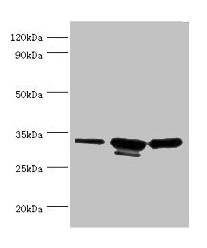
WB analysis of Jurkat (A), HeLa (B) and NIH-3T3 (C) lysates using GTX89785 CAPZB antibody, C-term. Dilution : 0.01microg/ml Loading : 35microg protein in RIPA buffer
CAPZB antibody, C-term
GTX89785
ApplicationsImmunoFluorescence, Western Blot, ImmunoCytoChemistry
Product group Antibodies
TargetCAPZB
Overview
- SupplierGeneTex
- Product NameCAPZB antibody, C-term
- Delivery Days Customer9
- Application Supplier NoteWB: 0.1-0.3microg/ml. *Optimal dilutions/concentrations should be determined by the researcher.Not tested in other applications.
- ApplicationsImmunoFluorescence, Western Blot, ImmunoCytoChemistry
- CertificationResearch Use Only
- ClonalityPolyclonal
- Concentration0.50 mg/ml
- ConjugateUnconjugated
- Gene ID832
- Target nameCAPZB
- Target descriptioncapping actin protein of muscle Z-line subunit beta
- Target synonymsCAPB, CAPPB, CAPZ, F-actin-capping protein subunit beta, capZ beta, capping actin protein of muscle Z-line beta subunit, capping protein (actin filament) muscle Z-line, beta, epididymis secretory sperm binding protein
- HostGoat
- IsotypeIgG
- Protein IDP47756
- Protein NameF-actin-capping protein subunit beta
- Scientific DescriptionThis gene encodes the beta subunit of the barbed-end actin binding protein, which belongs to the F-actin capping protein family. The capping protein is a heterodimeric actin capping protein that blocks actin filament assembly and disassembly at the fast growing (barbed) filament ends and functions in regulating actin filament dynamics as well as in stabilizing actin filament lengths in muscle and nonmuscle cells. A pseudogene of this gene is located on the long arm of chromosome 2. Multiple alternatively spliced transcript variants encoding different isoforms have been found.[provided by RefSeq, Aug 2013]
- Storage Instruction-20°C or -80°C,2°C to 8°C
- UNSPSC12352203
References
- González-Barriga A, Lallemant L, Dincã DM, et al. Integrative Cell Type-Specific Multi-Omics Approaches Reveal Impaired Programs of Glial Cell Differentiation in Mouse Culture Models of DM1. Front Cell Neurosci. 2021,15:662035. doi: 10.3389/fncel.2021.662035Read this paper







